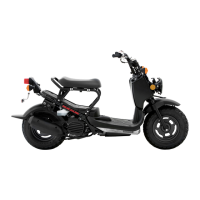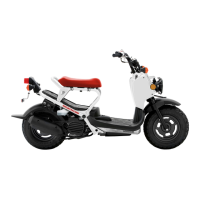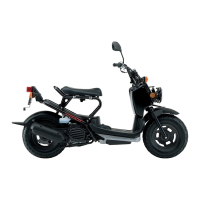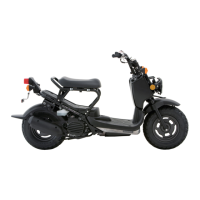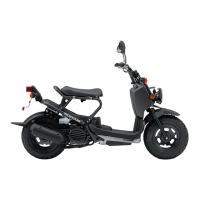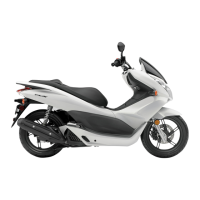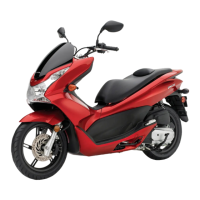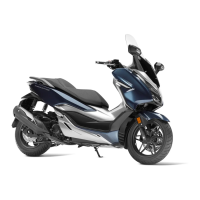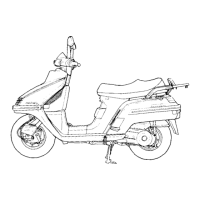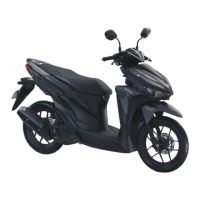
Do you have a question about the Honda RUCKUS NPS50 2022 and is the answer not in the manual?
| Compression Ratio | 12.0:1 |
|---|---|
| Transmission | Automatic V-Matic belt drive |
| Rear Suspension | Single shock; 2.6 inches travel |
| Front Brake | Drum |
| Rear Brake | Drum |
| Front Tire | 120/90-10 |
| Rear Tire | 130/90-10 |
| Seat Height | 28.9 inches |
| Fuel Capacity | 1.3 gallons |
| Wheelbase | 49.8 inches |
| MPG | 114 MPG |
| Width | 28.9 inches |
| Height | 40.4 inches |
| Ground Clearance | 5.7 inches |
| Engine Type | 49cc liquid-cooled 4-stroke single-cylinder |
| Fuel System | PGM-FI; automatic enrichment |
| Curb Weight | 194 pounds |
| Color Options | White |
| Bore x Stroke | 37.8 mm x 44.0 mm |
Essential guidelines for safe operation and maintenance of the vehicle.
Information on important safety labels found on the vehicle and their meanings.
Crucial precautions to ensure rider safety, including protective gear and defensive riding.
Guidelines for safe riding practices, including break-in, braking, and parking.
Advice on using approved accessories and warnings against unauthorized modifications.
Guidelines for safe loading, including weight limits and securement of cargo.
Procedure for inspecting the vehicle before riding to ensure it is safe.
Step-by-step instructions for starting the engine using electric or kick starter.
Guidance on basic riding actions like starting, accelerating, decelerating, and stopping.
Instructions on how to apply the front and rear brakes correctly for safe stopping.
Detailed steps for opening the fuel cap and refueling the vehicle safely.
Information on using the helmet holder and accessing the document bag.
Explains why regular maintenance is crucial for safety, performance, and longevity.
Details the recommended maintenance intervals for various vehicle components.
Covers essential principles for performing pre-ride inspections and periodic checks.
Guidelines on using genuine parts and the risks of non-genuine parts.
Instructions for battery care, including cleaning terminals and charging procedures.
Information on checking, selecting, and adding engine oil for optimal performance.
Procedures for checking and adding coolant to the reserve tank.
Guidelines for inspecting and adjusting brake levers and brake shoe wear.
Steps for checking and adjusting throttle freeplay for smooth operation.
Solutions for common starting problems, including starter motor issues.
How to identify and address engine overheating indicated by the temperature light.
Guidance on emergency tire repair and the risks associated with temporary repairs.
Troubleshooting tips for dead batteries, blown fuses, and burned-out light bulbs.
Details on recording key numbers, making duplicates, and key holder usage.
Explanation of the ignition switch, engine stop switch, odometer, and document bag.
Guidelines for washing, polishing, and protecting the vehicle's exterior.
Instructions for proper vehicle storage, including battery care and full-body covers.
Recommendations for safely transporting the vehicle using trailers or trucks.
Advice on using eco-friendly cleaners and recycling waste materials.
Information on locating and recording the VIN and engine serial number.
Overview of exhaust and crankcase emission control systems and their importance.
Guidelines to protect the catalytic converter and its function in reducing pollution.
Explanation of air-fuel mixture adjustments for high-altitude operation.
Information on using oxygenated fuels and potential issues with certain blends.
Information on obtaining service manuals and other Honda publications.
Details on vehicle warranties, maintenance exclusions, and service procedures.
How to report potential safety defects to NHTSA and Transport Canada.
Key physical dimensions, weight, and capacities of the vehicle.
Technical data including tire size, air pressure, spark plugs, oil capacity, and fuses.
